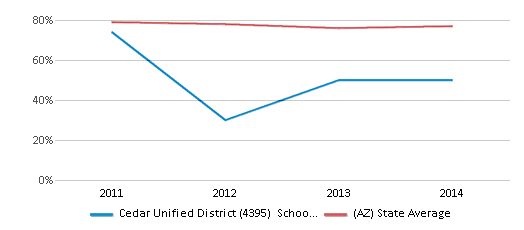Top Rankings
Cedar Unified District (4395) School District ranks among the top 20% of public school district in Arizona for:
Category
Attribute
Student Attention
Lowest student:teacher ratio (Top 1%)
For the 2025 school year, there is 1 public preschool serving 118 students in Cedar Unified District (4395) School District. This district's average pre testing ranking is 1/10, which is in the bottom 50% of public pre schools in Arizona.
Public Preschool in Cedar Unified District (4395) School District have an average math proficiency score of 5% (versus the Arizona public pre school average of 35%), and reading proficiency score of 8% (versus the 40% statewide average).
Minority enrollment is 100% of the student body (majority American Indian), which is more than the Arizona public preschool average of 67% (majority Hispanic).
Overview
This School District
This State (AZ)
# Schools
2 Schools
841 Schools
# Students
118 Students
395,515 Students
# Teachers
11 Teachers
23,860 Teachers
Student : Teacher Ratio
11:1
11:1
District Rank
Cedar Unified District (4395) School District, which is ranked within the bottom 50% of all 607 school districts in Arizona (based off of combined math and reading proficiency testing data) for the 2021-2022 school year.
Overall District Rank
#618 out of 631 school districts
(Bottom 50%)
(Bottom 50%)

Math Test Scores (% Proficient)
≤5%
35%

Reading/Language Arts Test Scores (% Proficient)
6-9%
40%

Science Test Scores (% Proficient)
≤20%
24%
Graduation Rate
(13-14)<50%
77%

Students by Ethnicity:
Diversity Score
0.08
0.64
# American Indian Students
113 Students
17,006 Students
% American Indian Students
96%
4%
# Asian Students
n/a
9,623 Students
% Asian Students
n/a
3%
# Hispanic Students
3 Students
195,352 Students
% Hispanic Students
2%
49%
# Black Students
n/a
22,513 Students
% Black Students
n/a
6%
# White Students
n/a
131,530 Students
% White Students
n/a
33%
# Hawaiian Students
n/a
1,496 Students
% Hawaiian Students
n/a
n/a
# Two or more races Students
2 Students
17,995 Students
% of Two or more races Students
2%
5%
Students by Grade:
# Students in PK Grade:
-
20,476
# Students in K Grade:
16
45,750
# Students in 1st Grade:
8
49,579
# Students in 2nd Grade:
16
52,288
# Students in 3rd Grade:
10
49,880
# Students in 4th Grade:
10
51,327
# Students in 5th Grade:
10
49,953
# Students in 6th Grade:
12
37,491
# Students in 7th Grade:
16
18,851
# Students in 8th Grade:
20
19,086
# Students in 9th Grade:
-
56
# Students in 10th Grade:
-
82
# Students in 11th Grade:
-
63
# Students in 12th Grade:
-
168
# Ungraded Students:
-
465
District Revenue and Spending
The revenue/student of $34,508 is higher than the state median of $11,421. The school district revenue/student has declined by 11% over four school years.
The school district's spending/student of $32,314 is higher than the state median of $11,323. The school district spending/student has declined by 11% over four school years.
Total Revenue
$4 MM
$12,837 MM

Spending
$4 MM
$12,727 MM

Revenue / Student
$34,508
$11,421

Spending / Student
$32,314
$11,323

Best Cedar Unified District (4395) School District Public Preschools (2025)
School
(Math and Reading Proficiency)
(Math and Reading Proficiency)
Location
Grades
Students
Rank: #11.
Jeddito School
(Math: ≤5% | Reading: 6-9%)
Rank:
Rank:
1/
Bottom 50%10
Mile Post 408 Highway 264
Keams Canyon, AZ 86034
(928) 738-2334
Keams Canyon, AZ 86034
(928) 738-2334
Grades: PK-8
| 118 students
Recent Articles

Year-Round Or Traditional Schedule?
Which is more appropriate for your child? A year-round attendance schedule or traditional schedule? We look at the pros and cons.

Why You Should Encourage Your Child to Join a Sports Team
Participating in team sports has a great many benefits for children, there is no doubt. In this article you will learn what those benefits are.

White Students are Now the Minority in U.S. Public Schools
Increasing birth rates among immigrant families from Asia and Central and South America, combined with lower birth rates among white families, means that for the first time in history, public school students in the United States are majority-minority. This shift in demographics poses difficulties for schools as they work to accommodate children of varying language abilities and socio-economic backgrounds.





